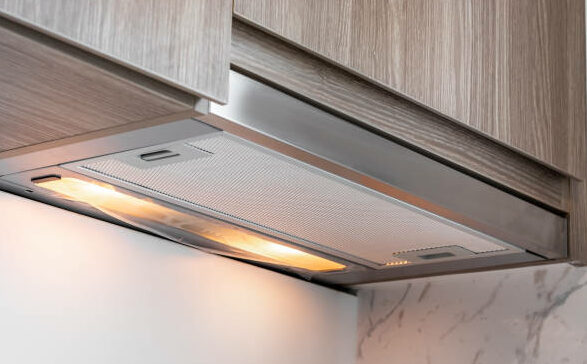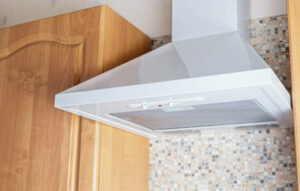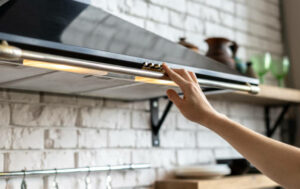When operating, the fan generally consumes between 100 watts (low suction, low noise) and 200 watts (full power). A range hood for a private home use between 20 and 150 kWh/year. The efficiency rating is calculated based on one hour of operation and two hours of lighting per day. The daily energy consumption depends on the use of the appliance in the household.
The energy label is only mandatory for exhaust ventilation systems. It does not apply to closed ventilation systems (hoods or extractor hoods). The reason is simple: this configuration is so variable that it is difficult to standardize the measurement protocol.

Table of Contents
Tips To Optimize the Use of a Kitchen Hood:
- A kitchen hood should be turned on 5 to 10 minutes before cooking begins (with no draft, to create a steady flow of suction throughout the cooking process) and turned off 5 to 10 minutes after the lights go out. Some hoods have a timer function that programs your hood to turn on and off.
- Your kitchen must be ventilated to ensure that the air is renewed and that the turbines of your hood operate without forcing.
- Make good use of your hood’s speeds:
- The first speed is recommended for low-heat cooking and sauces.
- The second speed is recommended for heavy cooking, grilling, or frying.
- The third speed is strongly recommended for cooking with strong grease or steam emissions. As soon as the grease or steam is sucked out, you should switch back to the second speed.
What Are the Most Efficient Kitchen Hoods?
The extractor hoods

This hood evacuates the fumes and vapors from the kitchen to the outside through a duct. In this sense, they are the most efficient models. They suck in the fumes and discharge them either through the roof or through the walls via a vent.
The recycling hoods

The recycling hood is a ductless hood. It works with a charcoal filter that purifies the air and eliminates bad smells. This filter must be replaced regularly (every 6 months maximum). It is better to have an exhaust fan because it evacuates the odor to the outside of the room.
Less efficient than the extractor hood, it does not evacuate the smoke and is often noisier. On the other hand, it is easier to install, because it does not require the installation of ventilation ducts. It does not evacuate the smoke but recycles the air before sending it back into the room. This is also known as a non-ventilated hood.
Cooking Hood Control Systems
Cooking hoods have three options for light and motor power control units. They differ in price, so it is necessary to consider when buying.
The simplest unit has a slide switch consisting of two slides.
One slides controls the lighting and has two positions (on/off). The second controls the power of the motor and has three positions corresponding to three motor speeds. Each speed corresponds to the power of the hood. The second control unit is a row of buttons on the front panel of the hood. By analogy with the slider, one of the buttons turns on the lights, the others control the motor. The speeds are engaged sequentially.
The last development is a pseudo-sensor control unit. It consists of 4 buttons that include the motor and light modes. The speeds are switched randomly. In addition, this device has a built-in electronic timer. It is programmed for 15 minutes, i.e., after turning it on, the hood runs for 15 minutes and the motor and light are turned off automatically.
Conclusion
A home air purifier, which you know better as a kitchen hood, is one of the most popular appliances for the home. The hood serves to preserve kitchen wall surfaces, furniture, eliminate food odors and protect the ceiling from soot.
A kitchen hood must meet your requirements in many respects: appearance, price, ease of use and maintenance, and, of course, high-quality air purification. That is why it is very important to pay attention to the technical parameters of kitchen hoods because they characterize the efficiency of work.
To do this, you need to evaluate its performance and the pressure created by the motor. The performance will show the compliance of the hood with the parameters of the kitchen, and the pressure (pressure) will allow you to assess the ability of the hood to remove air in the ventilation duct.
